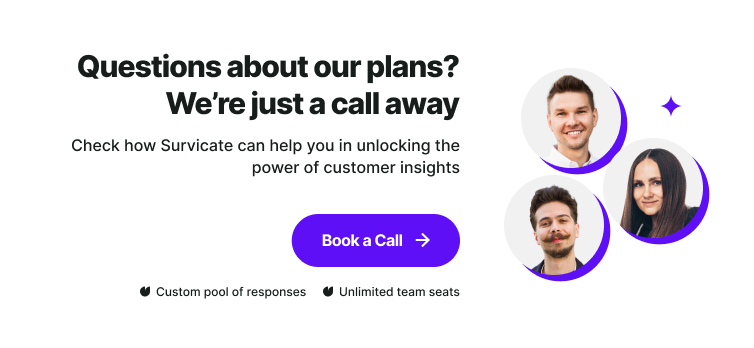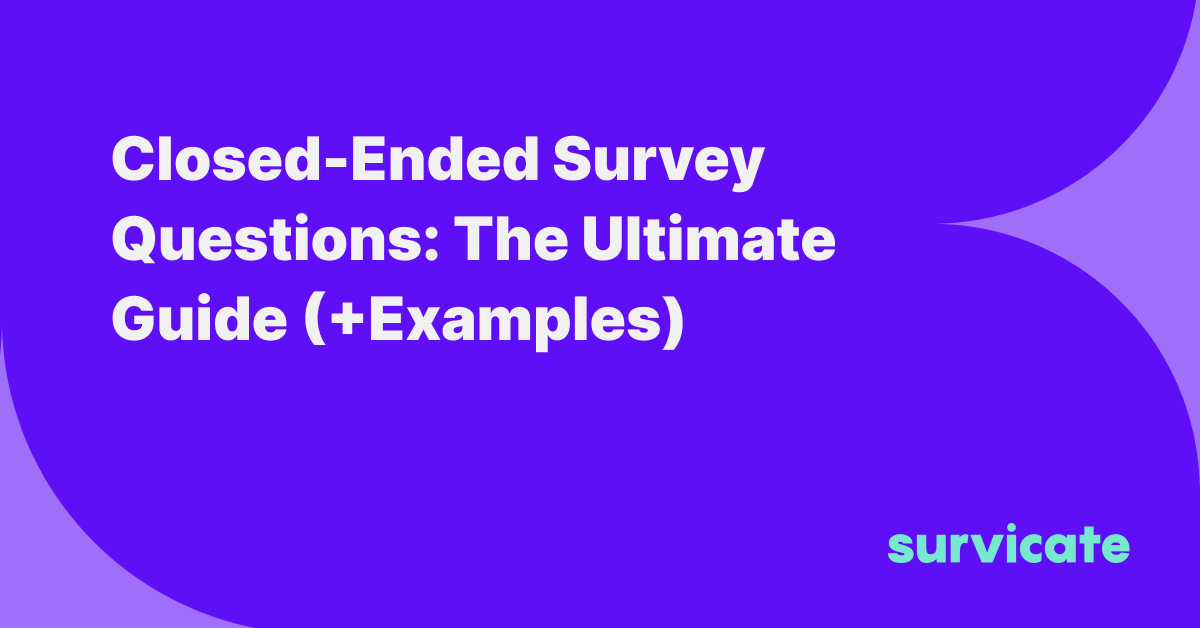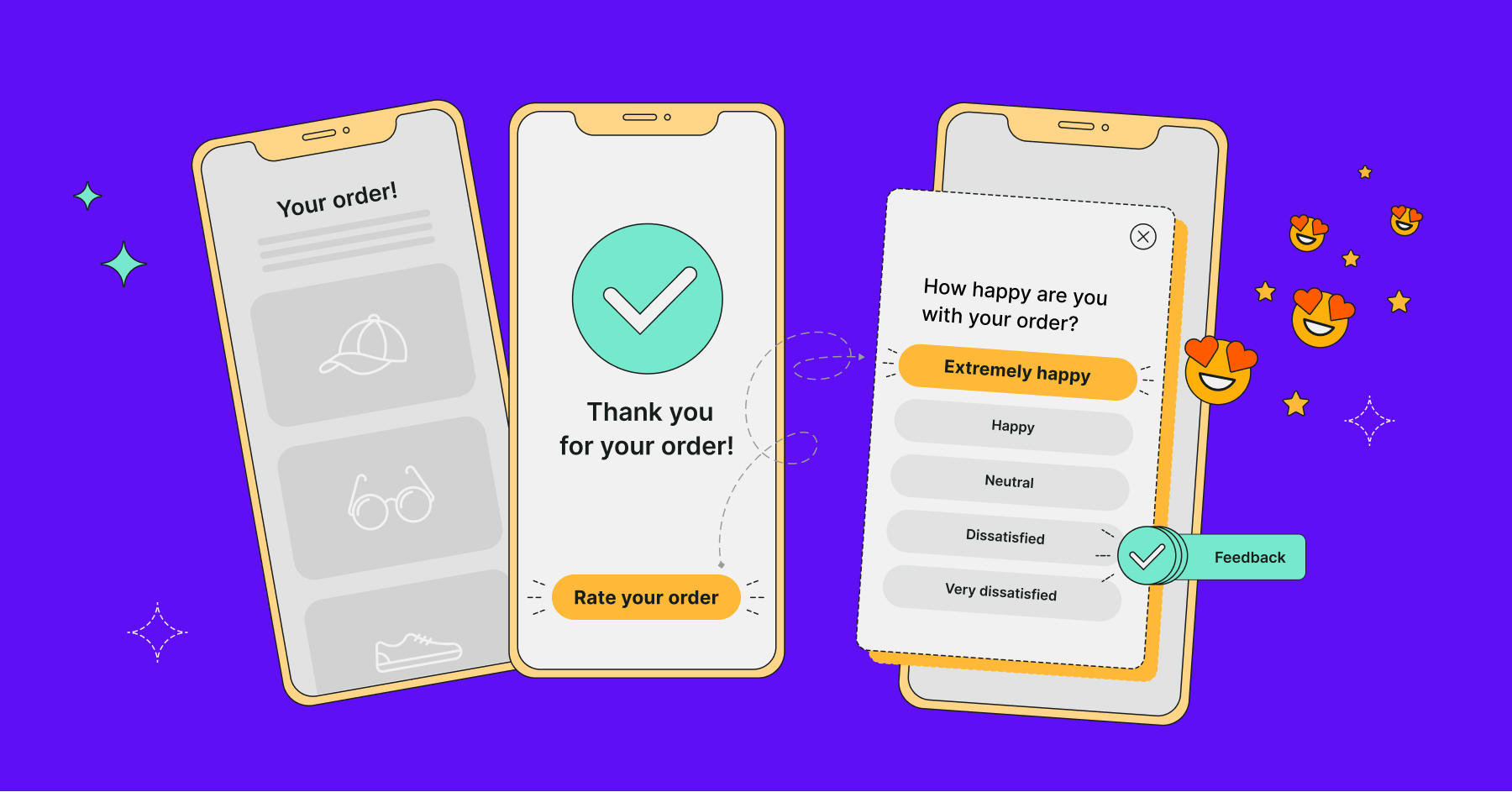To get the best survey response rates, you need to send your survey at the right time, to the right audience but most importantly, with adequate questions.
Today, we’ll be discussing closed-ended survey questions—what they are, when you should and shouldn't use them, as well as list some great examples to get you inspired for collecting quantitative data.

What are closed-ended questions?
Closed-ended survey questions are questions that have a limited number of answer choices. They are closed in the sense that the respondents have only a few answer options to choose from.
They are the opposite of open-ended questions, which allow participants to respond with anything they want as by filling in a blank.
Types of closed-ended questions
Importantly, not all closed-ended questions are the same. There are a few subtypes you need to keep in mind to collect data effectively.
Dichotomous survey questions
These are questions that only have two options to choose from, usually as a one-word answer. Typical examples of dichotomous questions include yes/no questions and true/false questions. With only two options to choose from, responding is super easy for the participants, and so is the statistical analysis on your end.
Dichotomous questions are great if you want a quick, single-word answer. However, bear in mind that you’re also limiting the kind of customer feedback you can get, so research if more options are possible before setting up limitations.
Example:
Have you used any car insurance services in the past 6 months?
- Yes/No
This can lead to more questions in the next surveys you send out.
Multiple-choice questions
These are your most typical survey questions. In multiple-choice questions, you give respondents several choices, after careful user research and determining that these are the right choices to place in front of your respondents.
Multiple-choice questions are amazing if you want to analyze and collect quantitative data and qualitative feedback quickly. However, they also limit the choices your respondents can make unless you leave an option for “other” or fill out a blank.
Example:
What is your preferred interval for receiving reports?
- Weekly
- Biweekly
- Monthly
- Quarterly
- Other (please specify)
Rating scale survey questions
As the name suggests, these survey questions ask your respondents to rate the available answers on a scale. How many choices you give respondents depends on your preference and the kind of information you need to collect. However, rating scale questions usually have up to five answers.
You can get creative with this question type as there are various types of rating scales to collect quantifiable data, including:
- Numerical rating scale (1-5, 1-10, etc.)
- Star rating scale (rate something with a number of stars)
- Descriptive rating scale (from “I fully agree” to “I strongly disagree”)
- Graphic rating scale (choosing a number or an option in a table)
This is an effective question type but make sure you’re using it in the right use case. If you’re not sure if you need this question type, take a look at our extensive library of survey templates to find a use case that matches your needs.
Likert scale survey questions
This is a subtype of rating scale survey questions and one of the most common survey question types. Likert scale questions are used for collecting data and determining your respondents’ attitudes toward a certain topic. They usually have five, seven, or nine answers to choose from.
Example:
How satisfied are you with the checkout experience in our web store?
- Very dissatisfied
- Dissatisfied
- Neutral
- Satisfied
- Very satisfied
Ranking-style survey questions
The question type is pretty self-explanatory. You give the participants a list of items and ask them to rank their choices on a scale. Usually, there are multiple items to choose from and the respondents need to arrange them in order of importance.
Example:
Please rank the following in order of importance to you when purchasing items from an online store:
- Cost of the items
- Cost of shipping
- Return policy
- Availability of payment options
Checklist survey questions
This is yet another popular closed-ended question type. With these multiple-choice questions, you’re asking your survey participants to tick off items on a checklist.
The list of items needs to be definitive—ideally, there should be no other answer options besides the ones you listed.
Example:
What is your marital status?
- Single
- In a relationship
- Married
- Widowed
- Don’t want to disclose
Closed-ended vs open-ended questions
Now that you know the types of closed-ended questions you can ask, you may be asking yourself if using open-ended questions may be a better alternative or an addition to closed-ended ones. There are some important factors to keep in mind.
What is an open-ended question?
In open-ended questions, you give your respondents the option to fill in a blank with their responses in their own words.
They don’t offer alternatives to choose from like in multiple-choice questions, and can require more time and effort to fill out.
Instead, there’s a blank field that lets the respondents answer freely and write as little or as much as they want.
Example:
Please describe the interaction you had with our customer support agent in a few sentences.
When to use close-ended vs. open-ended questions
The main difference between the two types of questions is in the type of feedback that you can collect. Closed-ended questions are amazing for quantitative feedback as it’s easy to measure the results and even easier to do data analysis when you’re using advanced survey software.
On the other hand, open-ended survey questions facilitate qualitative data. They let your customers share their thoughts without limiting themselves to any answer choices. As such, they’re amazing if you want to collect deeper insights. The only downside is that the survey responses are much harder to analyze as you have to read them one by one.
For example, you could run a survey with multiple-choice questions to ask your customers to rate the quality of customer support. If you want to get more information about a particular customer support agent, you can ask an open-ended question where the customer can provide detailed feedback.
The good news is that with Survicate, you can combine the two types of questions in one survey if you want to get both quantitative and qualitative data. We’ll show you how you can do this in a minute.
Advantages and disadvantages of using closed-ended survey questions
Let’s take a look at some of the benefits and disadvantages of using closed-ended questions in your surveys.
Advantages of using closed-ended questions
There are plenty of them and here are some of the main ones you should know.
They’re easier to answer
Worried about survey fatigue? You shouldn’t be with this question type. Respondents can choose their preferred option with just a few clicks. Compare this with open-ended questions where they have to type out entire sentences to complete a single answer.
They let you get quantitative data quickly
Want to get a better understanding of how many people love or hate your new feature? Don’t wait for a descriptive answer, because a closed-ended question tells you how many people voted for a certain option: whether they love it, hate it, or something in between.
This quantifiable data makes it easier to compare data points and it’s a superb way to make better, more informed decisions.
They’re easy to customize
You can edit closed-ended surveys extremely easily. Whether you’re building a survey from scratch or using a template, editing the question or the answers is a matter of a few clicks.
They have better response rates
The fact that closed-ended questions are easy to fill out translates into better response rates. While this does have a downside (more on that in a minute), responding to a closed-ended survey is super fast for your users.
Their results are easier to analyze
You don’t have to dig deep into each survey response for statistical analysis. All you have to do is look at your Survicate dashboard to see a breakdown of the responses. That means you have massive insights instantly as opposed to having to analyze and collect survey responses for weeks to get some statistical significance.
Disadvantages of using closed-ended questions
There are some pitfalls to be aware of with this question type.
They limit your customers’ answer choices
Are you absolutely sure you included all the possible choices in a multiple-choice question? You need to cover all bases, and even then, there may be an option that your customers want to pick but cannot. In other words, you’re forcing them to choose one (or more) of the available alternatives and they can’t voice their opinion beyond the offered choices.
They’re not great for capturing qualitative data
As discussed above, closed-ended questions can get you some qualitative data, but not a lot. To get rich insights, you need to ask open-ended questions to get your customers to truly voice their opinions.
They can lead to biased answers
Unless you’re using a tried and tested survey template, creating a flawed and biased survey with closed-ended is extremely easy. You can make the responses biased in a way that they meet your agenda or suit your purposes and then the respondents have no choice but to choose one of the available, irrelevant answers.
For instance:
How did you find our reception staff?
- They were amazing
- They were just okay
- They could be better
While this is just an example, it shows what can happen when you don’t offer an appropriate range of answers. You’ll end up getting inaccurate data that can affect your entire decision-making process.
They force people to answer even if they don’t have a suitable response.
Sometimes, your customers just don’t have an opinion on something. If you’re designing your surveys from scratch, you might leave out an option that might be relevant to the respondents. As a result, they’re forced to choose one of the available answers that does not necessarily hold true for them.
Closed-ended question examples
We provided a few examples of closed-ended questions above, but here are some more to get you inspired for your next survey.
- How satisfied are you with our customer service?
- Very dissatisfied
- Dissatisfied
- Neutral
- Satisfied
- Very satisfied
- Product X made it easy for me to do [activity name].
- 1-5 ranking scale
This is a CES survey question, used to gauge how difficult (or easy) it is for customers to perform a certain action. Many businesses use our CES survey template to ask this question:
- Which type of mobile device do you use?
- Apple (iOS)
- Android
- Windows
- Other
- How satisfied are you with our product?
- 0-5 rating scale
This is a CSAT survey and you can use one for your own product, too. All you need is our CSAT survey template to get started:
- Which features in our app do you find the most useful, ranked from 1 to 5?
- The dashboard
- The marketplace
- The Zapier integration
- The 24/7 customer support
- The automated reports
- Do you agree with the following statement?
- Yes
- No
- In the past 6 months, how often have you used a project management tool?
- Once or twice
- Three times or more
- Never
- How did you hear about our business?
- I found it on Google
- I saw it on a social media ad
- A friend recommended it to me
- I read a review online
- Other
- Is our pricing model clear to you?
- Yes
- No
10. On a scale from 0 to 10, how likely are you to recommend our product to a friend?
- 0-10 scale
This is an Net Promoter Score (NPS) survey question. You can you grab our NPS survey template from our library:
Start using closed-ended questions and capture quantitative data today
If this all sounds too complex for you, we understand. Closed-ended questions are a great tool, but only if you use them the right way. Asking the right questions and even more importantly, providing the right answers, can be incredibly difficult.
That’s why we suggest sticking to things that work. Check out our library of over 125 survey templates with closed-ended (and open-ended) questions. There are hundreds of use cases to choose from and the questions and answers are framed in a way that yields the best survey results.
Start your journey to customer-centric decision-making with Survicate. Sign up for a free account and enjoy a 10-day trial with essential features. Don't miss our pricing.

.webp)






.svg)
.svg)
.svg)

.svg)


.svg)







.svg)




.svg)

















.svg)






























.svg)

.svg)
.svg)

.svg)



.svg)







.svg)

.svg)



.png)
.jpg)



